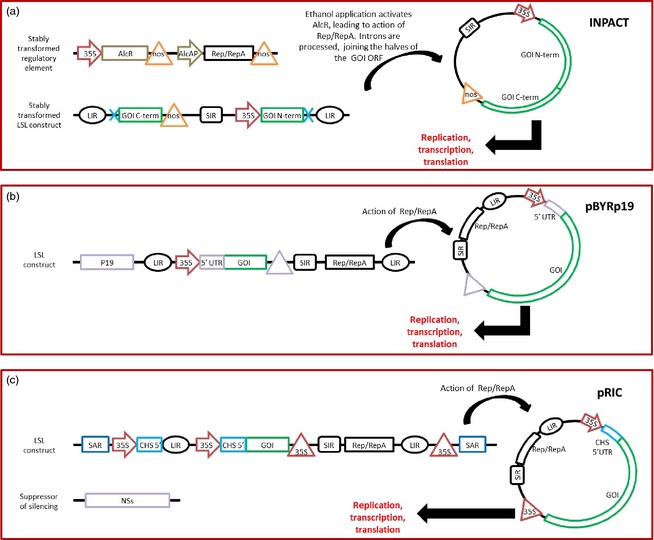Figure 4.

Simplified diagrams of deconstructed geminivirus‐based expression systems. (a) The INPACT system (Dugdale et al., 2013) is composed of two elements which are transformed stably into the plant genome. The regulatory element contains ethanol‐inducible Rep/RepA gene, while the LSL construct contains the gene of interest (GOI) split in half with introns immediately upstream of the C‐terminal half and immediately downstream of the N‐terminal half. When activated by ethanol, Rep/RepA circularize the LSL construct at the LIRs, and processing of the introns leads to loss of the LIR and recombination of the two halves of the GOI open reading frame. 35S arrow: 35S promoter, AlcR: ethanol‐activated transcription factor, nos triangle: nos terminator, AlcAP arrow: AlcR‐activated promoter, LIR: long intergenic region, blue cross: introns, SIR: short intergenic region. (b) The pBYRp19 system (Chen et al., 2011) is composed of a single construct carrying the TBSV P19 silencing suppressor as well as an LSL which contains both the Rep/RepA functions and the GOI. There are multiple versions of the vector: in pBYR1, the translational enhancer (5′ UTR) is the tobacco etch virus 5′ UTR and the terminator (triangle) is soya bean vspB 3′ region, whereas in pBYR2, the translational enhancer is TMV Ω, and the terminator is the extensin gene 3′ region. (c) The pRIC system (Regnard et al., 2010) is composed of an LSL replicon inserted into the multiple cloning site of a pTRAc vector. The pTRAc vector T‐DNA is flanked by SAR elements (scaffold attachment region of the tobacco Rb7 gene), and the LSL contains the Rep/RepA functions as well as the GOI, which is under the control of the 35S promoter (arrow) and terminator (arrow), with chalcone synthase 5′ UTR as a translational enhancer (CHS 5′). The NSs silencing suppressor from tomato spotted wilt virus is typically co‐infiltrated. Upon action of Rep/RepA, all of these expression systems form circular replicons that are capable of replication, transcription and translation, but not cell‐to‐cell or systemic movement.
